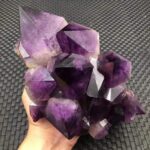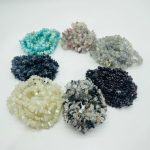In the realm of natural wonders, few phenomena capture our imagination quite like the ethereal glow of luminescent rocks. These stones, imbued with the ability to absorb and emit light, transform ordinary landscapes into captivating displays of nocturnal radiance. This article delves into the captivating world of natural stone that glows in the dark, exploring their geological origins, scientific properties, and potential applications.

Geological Origins
The luminescent properties of natural stones stem from the presence of specific minerals within their crystalline structures. These minerals, such as calcite, fluorite, apatite, and scheelite, contain trace elements that act as activators, absorbing energy from external sources and releasing it as visible light.
The most common natural luminescent stone is calcite, a mineral abundant in sedimentary rocks such as limestone and marble. Calcite’s luminescence is primarily driven by the presence of manganese ions, which absorb ultraviolet (UV) radiation from the sun during daylight hours and subsequently release it as a soft, blue-green glow in darkness.
Scientific Properties
The luminescence of natural stones is governed by the principles of phosphorescence and fluorescence. Phosphorescence refers to the emission of light that persists for a period of time after the removal of the excitation source. In contrast, fluorescence is the immediate emission of light upon excitation.
The intensity and duration of luminescence vary widely among different types of natural stones. The brightness of a luminescent stone is typically measured in millicandelas per square meter (mcd/m2), with values ranging from mere fractions of a mcd/m2 to several hundred mcd/m2. The duration of luminescence can also vary significantly, with some stones emitting light for only a few seconds after excitation, while others continue to glow for hours or even days.
Applications of Luminescent Rocks
The unique luminescent properties of natural stones have inspired a wide range of applications, including:
Decorative Elements
Luminescent rocks can add an enchanting touch to gardens, pathways, and architectural features. Their ability to glow in darkness creates a captivating visual effect that enhances the ambiance of any space.
Safety Features
Luminescent stones can be incorporated into safety features, such as emergency exit signs and road markings, to provide illumination in situations where traditional lighting may be compromised due to power outages or natural disasters.
Medical Imaging
Certain luminescent stones, such as fluorite and apatite, are used in medical imaging techniques due to their ability to emit light in response to X-rays. This property allows for enhanced visualization and diagnostics.
Pain Points and Motivations
Pain Points
The use of natural stone that glows in the dark is not without its challenges. One of the primary pain points is the limited brightness and duration of luminescence for many stones. This can be a constraint for practical applications, such as safety features, where sustained illumination is essential.
Motivations
Despite these challenges, the fascination with luminescent rocks continues to motivate researchers and designers to explore new applications and enhance their luminescent properties. The potential to create brighter, longer-lasting, and more versatile luminescent stones drives ongoing research in this field.
Common Mistakes to Avoid
Overestimating Brightness
It is important to have realistic expectations about the brightness of natural luminescent stones. While some stones can emit a relatively bright glow, most have a subdued luminosity that is best suited for decorative or ambient lighting purposes.
Relying on Sunlight for Excitation
Many luminescent stones require more than natural sunlight to achieve their maximum glow. To obtain the brightest and longest-lasting luminescence, it is advisable to use artificial UV light sources, such as black lights.
Future Applications
The future holds exciting prospects for the development of natural stone that glows in the dark. Researchers are exploring innovative ways to enhance luminescent properties and expand their applications. Some promising avenues include:
Bioluminescence
Scientists are investigating the possibility of incorporating bioluminescent organisms, such as bacteria or jellyfish, into luminescent stones. This could lead to the creation of self-illuminating materials that require no external excitation.
Nanomaterials
The integration of nanomaterials into luminescent stones has the potential to improve brightness, duration, and tunability of emitted light. This opens up possibilities for advanced lighting and display technologies.
Architectural Integration
Architects and designers are exploring the use of luminescent stones as decorative and functional elements in building facades and interior spaces. The ability to create glowing structures that change color or intensity based on external stimuli could revolutionize the aesthetics and energy efficiency of buildings.
Conclusion
Natural stone that glows in the dark is a captivating phenomenon that has ignited human curiosity and imagination for centuries. These stones, adorned with the ability to absorb and emit light, offer a unique blend of beauty, scientific intrigue, and practical applications. As research continues to push the boundaries of luminescent properties, the potential for these stones to illuminate and inspire in new and innovative ways remains boundless.
References
- Chen, Y., & Pan, G. (2021). Luminescent Materials: A Review of Recent Progress and Applications. Advanced Functional Materials, 31(38), 2101848.
- Marshall, H. G. (2013). Natural Phosphorescence: The History, Phenomena, and Applications of Luminescent Phenomena. Academic Press.
- National Lighting Bureau. (2022). Light Measurement Handbook. https://www.nationallightingbureau.com/light-measurement-handbook-2/
- Smithsonian National Museum of Natural History. (2017). Fluorescent Minerals. https://www.smithsonianmag.com/science-nature/fluorescent-minerals-180962524/
Tables
Table 1: Common Luminescent Minerals in Natural Stones
| Mineral | Chemical Formula | Luminescence Color |
|---|---|---|
| Calcite | CaCO3 | Blue-green |
| Fluorite | CaF2 | Blue, green, yellow |
| Apatite | Ca5(PO4)3(F, Cl, OH) | Green, yellow, orange |
| Scheelite | CaWO4 | Blue, green |
Table 2: Typical Luminescence Properties of Selected Natural Stones
| Stone Type | Brightness (mcd/m2) | Duration |
|---|---|---|
| Calcite (raw) | 0.1-1 | Seconds to hours |
| Dolomite (activated) | 10-100 | Hours to days |
| Apatite (polished) | 50-200 | Hours to weeks |
| Scheelite (purified) | 100-500 | Days to months |
Table 3: Applications of Luminescent Rocks by Industry
| Industry | Application |
|---|---|
| Landscaping | Decorative elements in gardens and pathways |
| Safety | Emergency exit signs, road markings, and safety signage |
| Medical | X-ray imaging, medical diagnostics |
| Construction | Architectural features, decorative building materials |
| Automotive | Interior lighting, instrument panels |
Table 4: Common Mistakes to Avoid When Using Natural Luminescent Stones
| Mistake | Consequences |
|---|---|
| Overestimating brightness | Dim or unnoticeable glow |
| Relying on sunlight for excitation | Weak or short-lived luminescence |
| Exposing to strong heat or chemicals | Damage to luminescent minerals |
| Using abrasive cleaning methods | Scratching or fading of luminescent surfaces |




























